Comparison of first-generation manned spacecraft

It is interesting to see how different people solve the same problem. Everyone has their own experience, their own initial conditions, but when the goal and requirements are similar, the solutions to this problem are functionally similar to each other, although they may differ in their specific implementation. In the late 1950s, both the USSR and the USA began to develop manned spacecraft for the first steps into space. The requirements were similar - the crew was one person, the time spent in space was up to several days. But the devices turned out to be different, and it seems to me that it would be interesting to compare them.
Introduction
Neither the USSR nor the United States knew what awaited a man in space. Yes, in flights on an airplane, weightlessness can be reproduced, but only ~ 30 seconds in duration. What will happen to a person with prolonged weightlessness? Doctors frightened the inability to breathe, drink, see (supposedly the eye must lose its shape due to the incorrect work of the eye muscles), to think (frightened by insanity or loss of consciousness). Knowledge of high-energy cosmic particles led to thoughts of radiation injuries (and even after flying regularly, terrible versions of radiation sickness of flying cosmonauts surfaced in newspapers). Therefore, the first ships were designed for a short time in space. The duration of the first flights was measured in minutes, the next - in hours, or in turns around the Earth (one turn - approximately 90 minutes).
Removal vehicles
The main factor influencing the design of the ship was the payload of the launch vehicle. Both the two-stage R-7 and Atlas could bring about 1300 kg into low near-earth orbit. But for the "seven" they managed to work out the third stage in the lunar launches of 1959 - the "E" block, increasing the payload of the three-stage rocket to 4.5 tons. But the United States still could not work out the basic two-stage Atlas, and the first theoretically possible version of Atlas-Agena flew only in the early 1960s. The result was a joke - the Soviet Vostoki weighed 4.5 tons, and the mass of Mercury was comparable to the mass of Sputnik-3 - 1300 kg.
External structural elements
Consider first the outer part of the ships:
')
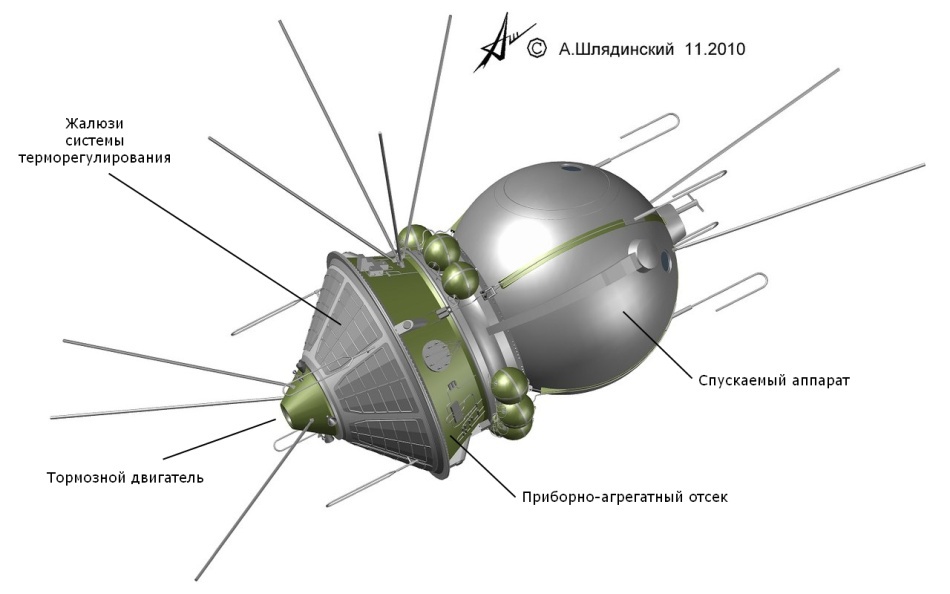
"East"
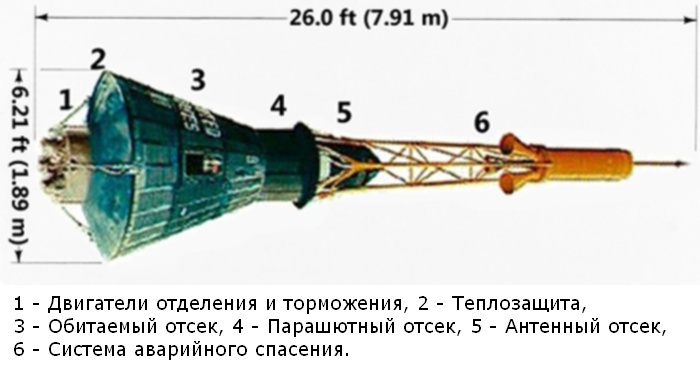
"Mercury"
Body shape
"Vostok" in the launch site was located under a drop fairing. Therefore, the designers did not care about the aerodynamic shape of the ship, and it was also possible to safely place antennas, cylinders, thermostatic blinds and other fragile elements on the surface of the device. And the design features of the “E” block determined the characteristic conical “tail” of the ship.
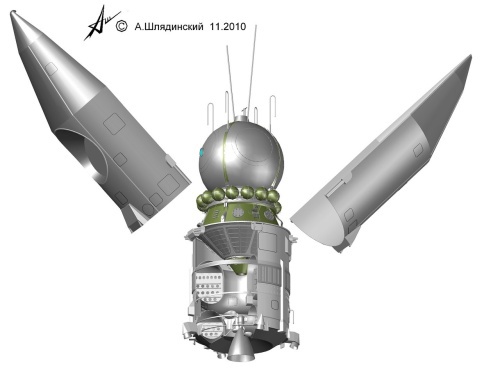
“Mercury” could not afford to drag a heavy fairing into orbit. Therefore, the ship had an aerodynamic conical shape, and all sensitive elements such as the periscope were retractable.
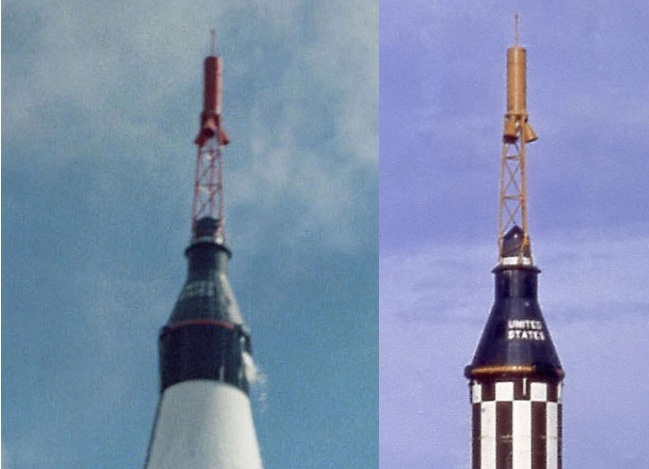
Heat protection
When creating the "Orient", the designers proceeded from solutions giving maximum reliability. Therefore, the shape of the descent vehicle was chosen as a ball. The uneven distribution of weight ensured the effect of “vanka-vstanka”, when the descent vehicle independently, without any control, was installed in the correct position. A thermal protection was applied to the entire surface of the descent vehicle. When braking about the dense layers of the atmosphere, the impact on the surface of the ball was uneven, therefore the layer of thermal protection had a different thickness.
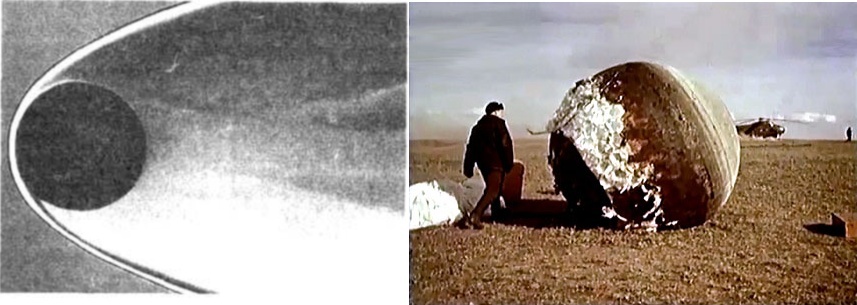
On the left: a flow around a sphere at hypersonic speed (in a wind tunnel), on the right: an unevenly burned descent vehicle "Vostok-1".
The conical shape of “Mercury” meant that thermal protection would be required only from below. On the one hand, it saved weight, on the other hand, the wrong orientation of the ship at the entrance to the dense layers of the atmosphere meant a high probability of its destruction. On the top of the ship was a special aerodynamic spoiler, which was supposed to turn the "Mercury" astern.
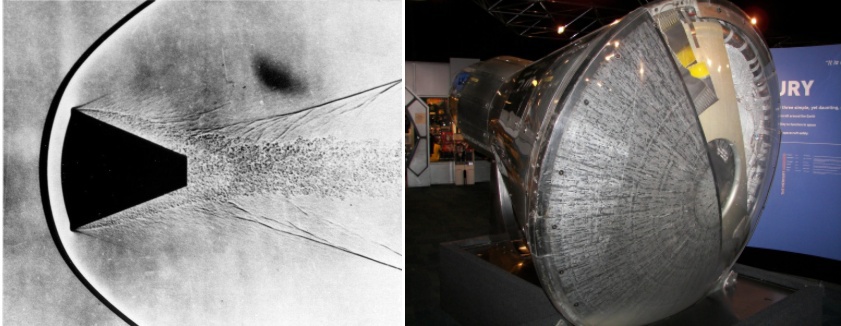
On the left: a cone at a hypersonic speed in a wind tunnel, on the right: thermal protection of the "Mercury" after landing.
Curiously, the material of thermal protection was similar - on the "East" resin-soaked asbestos fabric, on the "Mercury" - fiberglass and rubber. In both cases, the cloth-like material filled with filler burned in layers, and the filler evaporated, creating an additional layer of thermal protection.
Brake system
Brake engine "Vostok" was unreplicated. From a security point of view, this was not a good decision. Yes, the “Vostoki” were launched so that during the week they naturally slowed down about the atmosphere, but, firstly, already in Gagarin’s flight the orbit was higher than the calculated one, which actually “turned off” this backup system, and secondly, natural deceleration meant landing anywhere from 65 degrees north latitude to 65 degrees south latitude. The reason for this is constructive - two liquid propellant rocket engines did not fit into the ship, and solid-fuel engines were not mastered then. The reliability of the TDU increased the maximum simplicity of the design. There have been cases when the TDU gave a little less impetus than is needed, but there has never been a complete refusal.
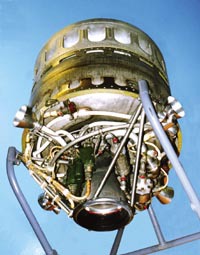
TDU "East"
On the "Mercury" behind the heat shield was block engine separation and braking. Both types of engines were installed in triplicate for greater reliability. The separation engines were switched on immediately after the rocket engine's engines were turned off so that the ship would move away from the launch vehicle to a safe distance. Brake engines were switched on for de-orbiting. In order to return from orbit, it was enough just one brake motor. The engine block was mounted on steel bands and dropped after braking.

TDU "Mercury"
Landing system
On the "Vostokah" pilot sat separately from the ship. At an altitude of 7 km, the astronaut catapulted and sat down independently on a parachute. For greater reliability, the parachute system was duplicated.
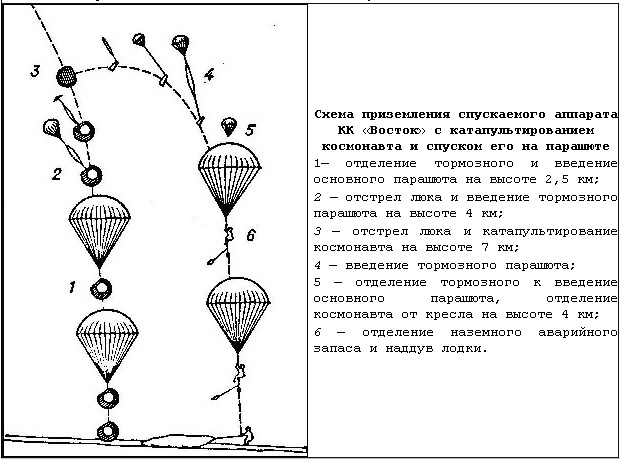
On the "Mercury" used the idea of landing on the water. The water softened the blow, and the large US fleet had no difficulty finding a capsule in the ocean. To mitigate the impact of water, a special air-absorber bag was opened.
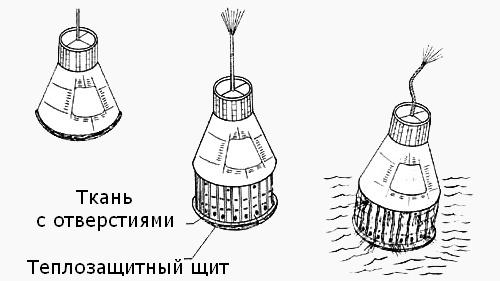
History has shown that the landing systems were the most dangerous in the projects. Gagarin almost sat in the Volga, Titov landed near the train, Popovich almost broke on the rocks. Grissom almost drowned with the ship, and Carpenter was searched for more than an hour and had already begun to be considered dead. In subsequent ships, there was neither a pilot ejection, nor a shock-absorber pad.
Emergency rescue systems
The cosmonaut’s ejection staffing system in the Vostok could work as a rescue system in the initial part of the trajectory. There was a hole in the fairing for the astronaut to land and for emergency ejection. The parachute could not have time to open up in the event of an accident in the first seconds of the flight, therefore the grid was stretched to the right of the launching table, which was supposed to soften the fall.
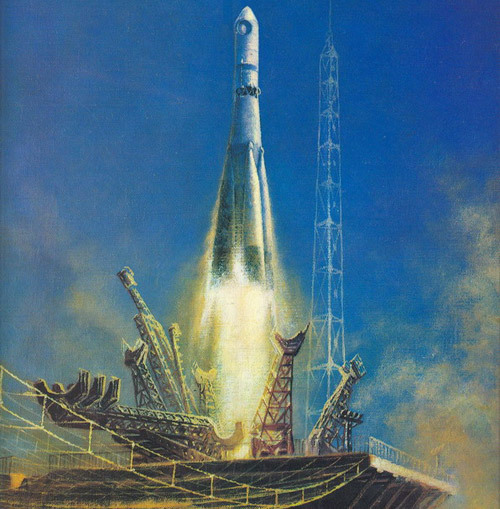
The grid below is in the foreground.
At high altitude, the ship was to separate from the rocket using standard separation means.
On the "Mercury" was an emergency rescue system, which was supposed to divert the capsule from the collapsing rocket from the start to the end of the dense layers of the atmosphere.
In the event of an accident at a high altitude, a standard separation system was used.
The ejection seats were used on the Gemini as a rescue system, as well as test flights of the Space Shuttle. CAC in the style of "Mercury" stood on the "Apollo" and is still put on the "Union".
Orientation engines
Compressed nitrogen was used as the working medium for orientation on the Vostok ship. The main advantage of the system was simplicity - the gas was contained in a balloon and was produced using a simple system.
On the ship "Mercury" was used catalytic decomposition of concentrated hydrogen peroxide. From the point of view of the specific impulse, this is more advantageous than compressed gas, but the reserves of the working medium on the Mercury were extremely small. By actively maneuvering, it was possible to spend the entire stock of peroxide in less than one turn. But its stock needed to be saved for orientation operations during landing ... The astronauts tacitly competed with each other, who would spend less peroxide, and Carpenter, who was into photography, got into a serious mess - he wasteding his working body for orientation and peroxide over during the landing process. Fortunately, the altitude was ~ 20 km and the disaster did not happen.
Later on, peroxide as a working body was used in the first Soyuz, and then everyone switched to the high-boiling components of UDMH / AT.
Thermoregulation system
On the "Vostoka" blinds were used, which then opened, increasing the radiating area of the ship, then closed.
On the "Mercury" was a system that uses evaporation of water in a vacuum. She was leaner and lighter, but there were more problems with her, for example, in Cooper's flight, she knew only two states - “hot” and “cold”.
Internal design elements
The internal layout of the ship "Vostok":
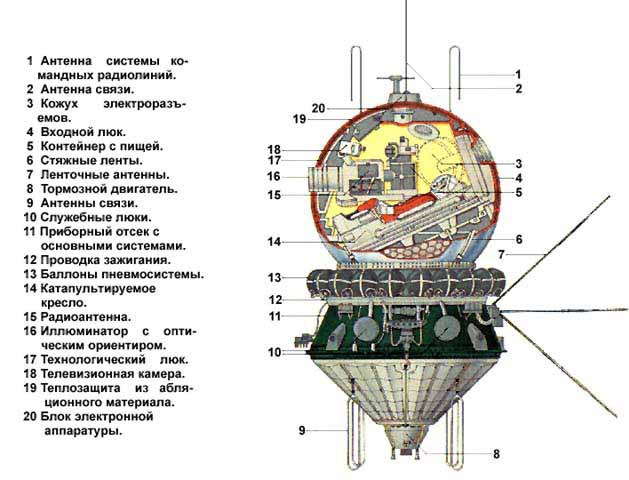
The internal layout of the ship "Mercury":

Toolbar
Toolbars most clearly show the difference in design approaches. Vostok was made by the rocket designers, so its toolbar is distinguished by a minimum of controls:

The photo

Left panel.
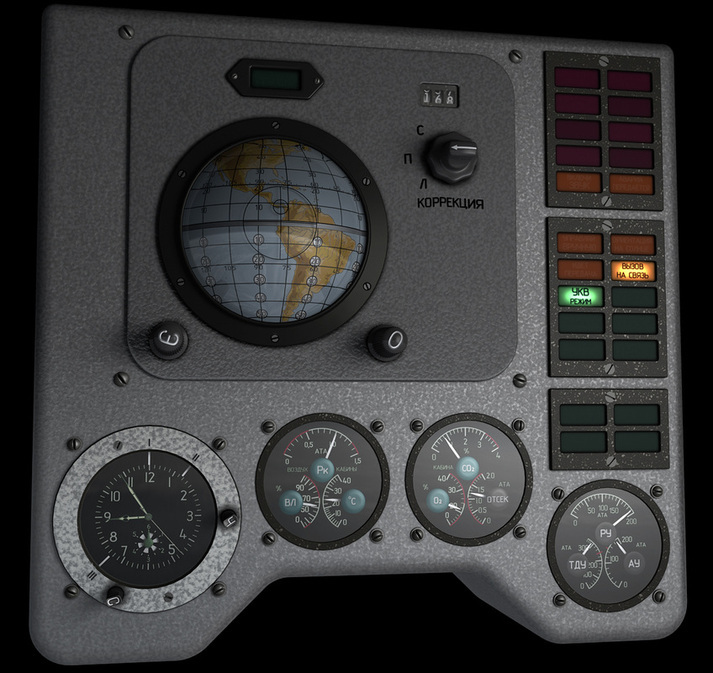
The main panel.
“Mercury” was made by former aircraft designers, and the astronauts made efforts to ensure that the cabin was familiar to them. Therefore, the controls are much more:

The photo.

Scheme.
At the same time, the similarity of tasks gave rise to identical instruments. And in the "East" and "Mercury" was a globe with clockwork, showing the current position of the device and the estimated landing site. Both on the Vostok and on the Mercury there were indicators of the flight stages - on the Mercury this is the “Flight Operations Management” on the left panel, on the “East” on the indicators “Descent-1”, “Descent-2”, “Descent- 3 "and" Prepare for ejection "in the central panel. Both ships had a manual orientation system:

"Gaze" on the "East". If the horizon is on the peripheral part from all sides, and the Earth in the center is moving from the bottom up, then the braking orientation is correct.
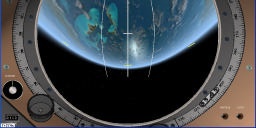
Periscope on the "Mercury". The marks show the correct orientation for braking.
Life supporting system
On both ships, the flight was carried out in spacesuits. In the "East" was maintained an atmosphere close to the earth - a pressure of 1 atm, oxygen and nitrogen in the air. On the "Mercury" to save weight, the atmosphere was pure oxygen under reduced pressure. This added some inconvenience — the astronaut needed to breathe oxygen in the ship for about two hours before launching; it was necessary to bleed the atmosphere out of the capsule during the removal, then shut off the vent valve, and when landing again open it to increase the pressure together with atmospheric.
The sanitary-hygienic system was more advanced on the “Vostokov” - for several days it was possible to meet the large and small needs. On the “Mercury” there were only urinals, a special diet saved from big hygienic problems.
Electrical system
Both ships used the energy of batteries. The “east” was more enduring, on the “Mercury” the daily flight of Cooper was completed in the face of a failure of a good half of the instruments.
Conclusion
Both types of ships were the top technology of their countries. Being the first, both types had both successful solutions and unsuccessful ones. The ideas embodied in “Mercury” live in rescue systems and conical capsules, and the grandchildren of “Vostok” still fly - “Photons” and “Bions” use the same spherical descent vehicles:
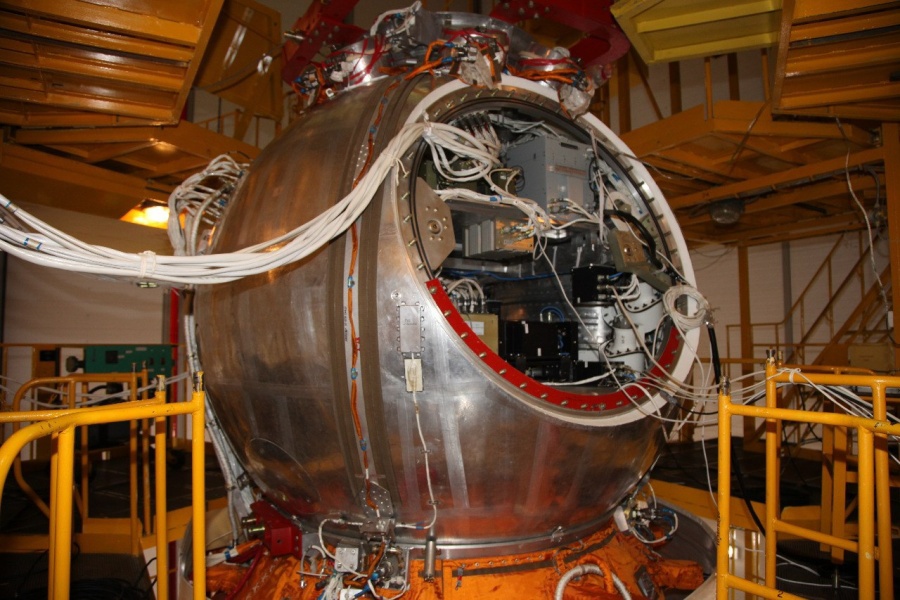
In general, the Vostoky and the Mercury proved to be good ships, which made it possible to take the first steps into space, and avoided fatal accidents.
Source: https://habr.com/ru/post/230445/
All Articles